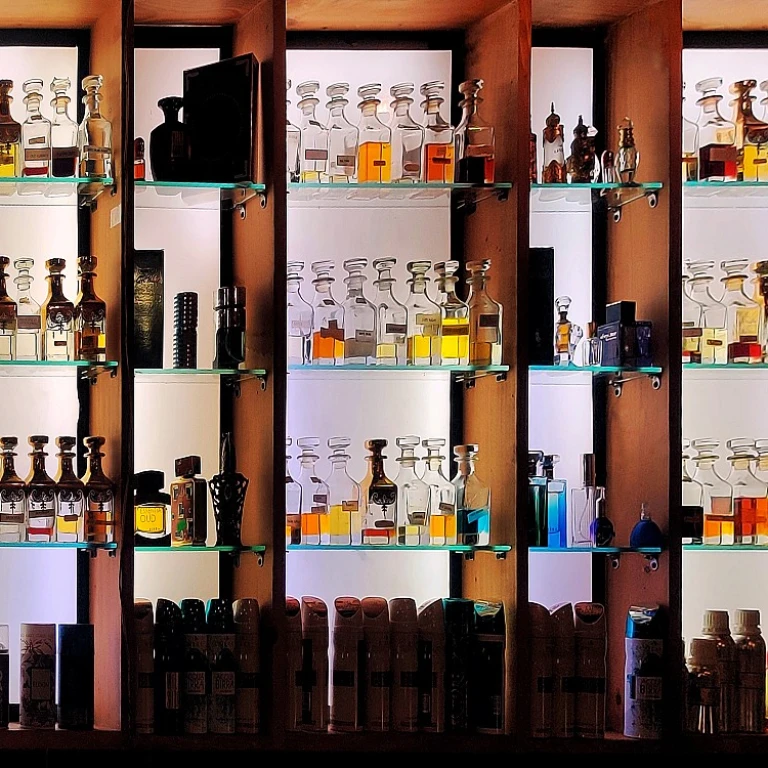Understanding the Fragrance Ingredients
The Complex Composition of Fragrances
The captivating allure of perfumes has enchanted humans for centuries, yet many are unaware of the complex cocktail of ingredients that go into creating these aromatic wonders. Perfumes consist of a mixture of natural and synthetic substances, combined to produce unique and memorable scents. Understanding these ingredients is crucial in identifying those that might be potentially harmful.
Fragrance formulations typically include essential oils, aroma compounds, fixatives, and solvents. Essential oils, derived from plants, are often seen as safer and more natural. However, the increasing demand for rare and exotic scents has led to a reliance on synthetic aroma compounds that can sometimes harbor dangerous chemicals.
The Role of Synthetic Ingredients
While natural ingredients are prized for their purity, synthetics play an essential role in the fragrance industry due to their versatility and cost-efficiency. However, not all synthetic compounds are made equal. Some, such as phthalates and synthetic musks, have been linked to health and environmental concerns. These chemicals can act as endocrine disruptors, affecting hormone regulation in humans and wildlife, a topic we'll delve into later.
Compounding this issue is the fact that the exact formulation of a fragrance is often a closely guarded secret, leaving consumers in the dark about the full extent of the ingredients they are applying to their skin. This lack of transparency makes it challenging to make informed decisions about personal care products.
To sidestep these potential pitfalls, some consumers are turning to simpler, more natural formulations and are exploring innovative alternatives such as
mood ring jewelry, which can complement their personal style without the uncertainties associated with conventional scents.
The Toxic Chemicals Lurking in Your Perfume
Unveiling the Toxic Compounds in Perfumes
As we take a closer look at the fragrant bottles lining our shelves, it's essential to be aware of what these beloved perfumes might be hiding. The enchanting scents we wear daily may contain certain chemicals that could be more harmful than they appear.
The intricate dance of aroma compounds in your perfume bottle often harbors a variety of synthetic chemicals. Phthalates, for example, are frequently used to help fragrances last longer on the skin. However, these ingredients have raised concerns due to their potential as endocrine disruptors, impacting hormonal balance and possibly leading to health complications over time.
Another culprit to watch for is synthetic musks. These compounds are often found in perfumes and have been linked to bioaccumulation in the body. Bioaccumulation refers to the gradual buildup of substances, which can lead to toxic effects, particularly if there is prolonged exposure.
Furthermore, volatile organic compounds (VOCs) are prevalent in many fragrances. They contribute to the luxurious scent profile but pose risks to both personal health and the environment. Exposure to high levels of VOCs can lead to respiratory issues and other health problems.
Identifying these toxic chemicals in perfumes is a crucial step in choosing products that are not only pleasant to wear but also safer for your well-being. As consumers become more aware of sustainable choices, there's an increasing push towards
eco-friendly perfumery that prioritizes health and environmental preservation.
The Impact of Perfume on Environmental Health
The Ripple Effect on Our Ecosystem
The world of fragrances often revolves around luxury, indulgence, and personal expression. However, the environmental impact of perfume compositions can be a sobering reality that often goes unnoticed. Traditional perfumes, while alluring to the senses, can carry a hidden ecological toll. As we examine the ingredients commonly found in these products, it's necessary to consider their journey beyond the bottle, trickling down into the broader spectrum of environmental health.
Many fragrances contain synthetic compounds that, once released into the ecosystem, do not break down easily. These chemicals can spread through waterways and soil, introducing pollutants that disrupt local wildlife and surrounding habitats. One glaring example is the presence of phthalates, commonly used as fixatives in perfumes to enhance durability. These chemicals have been shown to leach into aquatic ecosystems, leading to adverse effects on the reproductive health of aquatic species.
Furthermore, the production process itself can contribute to significant environmental degradation. The extraction of raw materials, such as rare flowers or animal-derived ingredients, has its own impact. For example, the sourcing of resources like ambergris from sperm whales involves ethical considerations, dual concerns for animal welfare and ecological balance.
For conscientious consumers wanting to make environmentally-informed choices, exploring alternatives can lead to discovering options like
Arabian perfume oil, which not only offer a unique olfactory experience but also often engage in more sustainable harvesting and production methods. The rise of eco-friendly and natural fragrance brands reflects a burgeoning awareness of scent sustainability and the desire to incorporate responsibility into our perfume preferences.
Taking a step back, it becomes clear that the perfume industry holds a significant stake in the health of our planet. The industry's implementations for sustainable practices and future advancements are indeed pivotal to mitigating its environmental footprint, as highlighted by earlier discussions on identifying and avoiding toxic chemicals. Aligning our preferences with the principles of environmental stewardship ensures that our choices do more than just invigorate our senses—they actively contribute to a healthier, more harmonious world.
Health Effects: From Allergic Reactions to Endocrine Disruption
Understanding the Health Implications of Toxic Perfume Ingredients
Perfumes, a staple in our beauty routine, can sometimes harbor hidden threats to our health. While many fragrances bring joy and confidence, certain concoctions may lead to less welcome effects due to their chemical composition. It’s crucial to become aware of these potential health hazards so we can make informed choices about the scents we wear.
First and foremost, allergic reactions are common among individuals sensitive to specific fragrance components. These reactions might manifest as skin irritation, redness, or respiratory discomfort. The likeliness of encountering these side effects can increase with frequent application of perfumes containing strong or synthetic chemicals.
Moreover, the impact of perfumes extends beyond surface-level reactions. A growing body of research suggests that certain fragrance components might interfere with the endocrine system – the body's hormone regulatory network. Endocrine disruptors present in perfumes have been associated with various health concerns, including effects on reproductive health and the possibility of promoting certain cancers. Being vigilant about the perfumes we use can play a pivotal role in minimizing exposure to these potentially harmful substances.
The long-term health implications of toxic perfume compounds are considerable and necessitate thoughtful consideration. As we navigate the enchanting world of scents, prioritizing safety over allure becomes vital. Along with recognizing toxic ingredients, exploring
natural and cruelty-free options can serve as a healthier alternative, offering peace of mind without sacrificing the aromatic pleasure that perfumes provide.
Choosing Safer Alternatives: Natural and Cruelty-Free Options
Embrace the Green Shift: Opt for Pure and Ethical Fragrances
In the quest for a fragrance that not only adorns you but also protects your health and the environment, choosing natural and cruelty-free perfumes has never been more paramount. As concerns about the toxic chemicals prevalent in many perfumes come to light, consumers are looking for alternatives that align with their values.
Natural perfumes typically harness the essence of plant-based ingredients, avoiding synthetic compounds that may trigger allergic reactions or disrupt hormonal balance. Essential oils, which capture the aromatic properties of plants, form the backbone of these eco-friendly concoctions. By embracing such nature-derived scents, you're making a conscientious decision that not only impacts your own well-being but also contributes to a healthier planet.
Furthermore, opting for cruelty-free fragrances is an ethical choice that speaks volumes about the values of a brand. This certification ensures that the perfume's production process never involves animal testing, offering peace of mind to the conscientious consumer.
It's also important to examine how these natural and ethical perfumes perform. While some may question their longevity and potency, the burgeoning market of green fragrances promises a range of options that combine high-quality and safety. With a growing number of artisanal and mainstream brands joining the movement, there is no shortage of luxurious yet sustainable choices available.
Products like these not only avoid the harmful chemicals identified earlier but also support biodiversity by sourcing ingredients responsibly. This trend represents a holistic approach to fragrance, merging personal care with the stewardship of environmental resources.
The fragrance world is indeed evolving. If you are considering a transition to a cleaner perfume, take heart in knowing that each purchase is a step towards a more sustainable future, mapped out by the broader efforts of consumers and regulatory bodies to safeguard health and the environment.
The Role of Regulatory Bodies and Consumer Advocacy
The Guardians of Fragrance Safety
In the realm of fragrances, ensuring safety not just for consumers but also for the environment hinges significantly on the role played by regulatory bodies and consumer advocacy groups. These institutions are tasked with setting safety standards, monitoring compliance, and promoting awareness about the potential risks associated with certain fragrance ingredients.
Regulatory bodies like the International Fragrance Association (IFRA) and national agencies such as the FDA in the United States take on the responsibility of scrutinizing the chemicals used in perfumes. They establish guidelines and limits to mitigate adverse health effects that could stem from prolonged exposure to potentially toxic ingredients, as discussed in previous parts of this series. By conducting scientific evaluations and risk assessments, these organizations aim to safeguard consumer health.
However, it is not just about setting the rules; enforcement plays a crucial role too. Regulatory bodies need to ensure compliance from fragrance manufacturers through regular audits and inspections. In some jurisdictions, non-compliance could lead to product recalls or fines, underscoring the importance of adhering to established safety standards.
Consumer advocacy groups, on the other hand, act as watchdogs, disseminating information and pushing for transparency in labeling and marketing practices. They urge fragrance companies to disclose all ingredients used in their products, enabling consumers to make informed choices, especially those prone to allergic reactions or other health issues highlighted in our insider tips.
The interplay between regulatory bodies and consumer advocates ultimately pressures the fragrance industry to respond with innovation, giving rise to natural and cruelty-free perfume options. These alternatives prioritize consumer health and environmental sustainability, aligning with the growing demand for ethical and safer fragrances.
In conclusion, while consumer awareness is pivotal, the ongoing efforts of both regulatory agencies and advocacy groups are indispensable to fostering a fragrance industry that values safety and transparency above all else.

